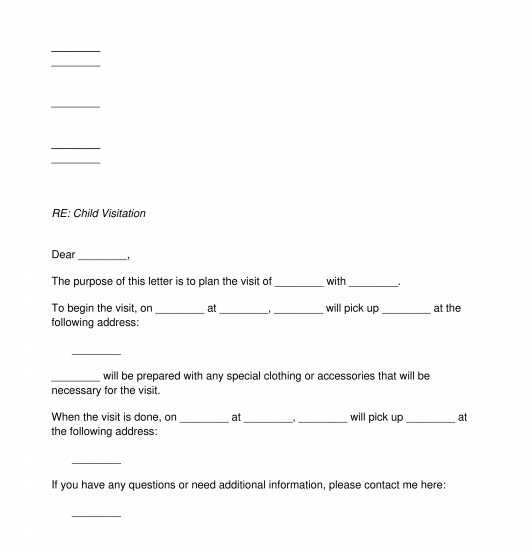 09/30/2025
09/30/2025

Answer a few questions and your document is created automatically.

Your document is ready! You will receive it in Word and PDF formats. You will be able to modify it.

 09/30/2025
09/30/2025
 Word and PDF
Word and PDF
 1 page
1 page



A Child Visitation Letter is a document used by one parent or guardian to arrange the visit of a child with the other parent or guardian. When partners with children split up, if they want to spend time with their children, visitation arrangements become necessary. For a person who has custody of the children or visitation rights, a Child Visitation Letter can be used to establish the specific details of the time to be spent with the kids. Once a divorce decree or parenting plan has been put in place, custody will usually be awarded to one parent with the other typically receiving visitation rights. There are also situations where grandparents might get visitation rights to their grandchildren. A Child Visitation Letter helps establish how those visitations will proceed. This letter can also be used if a parent or guardian has not been abiding by the agreed-upon visitation guidelines. In this instance, a Child Visitation Letter acts as a first warning putting the offending party on notice before anyone has to take legal action to have the visitation guidelines enforced.
A Child Visitation Letter is often used in conjunction with a Child Custody Agreement. The Child Custody Agreement is first completed to establish all of the details of how the parents or guardians will go about co-parenting their shared children. The letter is then used to establish the day-to-day arrangement of when and how visitations will take place. The Child Visitation Letter is used to help parents and guardians take the agreements they've come to the Child Custody Agreement and put them into practice in the real world.
How to use this document
This letter includes everything necessary to schedule a child visitation or address issues with adherence to existing child visitation guidelines. For scheduling a visit, the letter outlines the what, when, and how of the visit. It enables the letter writer to detail the time and location of the pickup or drop off of the kids at the start and end of the visit. There is also the option to describe any special activities that will happen during the visit that the receiver of the letter should know about.
In cases where someone is not abiding by the establishing visitation guidelines, this letter includes a description of what the guidelines are and how they have been violated. The sender of the letter can also choose whether or not they are considering pursuing further legal action and the deadline by which they need a response from the recipient of the letter to avoid escalating the situation to court.
Once this letter is written, it should be signed by the letter writer. The letter writer should also attach any relevant or necessary documentation, such as important parts of the divorce decree, parenting plan, or other agreements. The letter should then be mailed with a copy of the letter and any attachments being kept by the sender for their own records.
Applicable law
Child visitation is a matter of both state and federal law. Every state except Massachusetts has adopted the Uniform Child Custody Jurisdiction and Enforcement Act ("UCCJEA"). The UCCJEA dictates that child support and custody litigation pertaining to a particular child will occur in that child's home state, defined as the place where they have lived for six consecutive months prior to the litigation. If a child has not lived in any state for six consecutive months, their home state is defined as the state with significant connections to the child and at least one of the parents as well as substantial evidence regarding the child's care. Once a state takes the case, called jurisdiction, they then retain control over the case until a court decides that the child no longer has a connection to that state.
In determining matters related to children, such as child custody, visitation, and support, a Court must approve any arrangement using a "best interests of the child" standard. Generally, if both parents come to an agreement regarding these matters, a Court will be willing to include the agreement in the official legal documents. However, the possibility remains that a Court will require an adjustment of the agreement if they determine that the arrangement is not in the best interests of the children involved.
How to modify the template
You fill out a form. The document is created before your eyes as you respond to the questions.
At the end, you receive it in Word and PDF formats. You can modify it and reuse it.
A guide to help you: How to Send a Letter
Child Visitation Letter - FREE - Sample, template
Country: United States